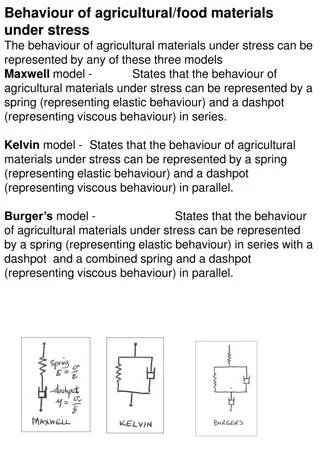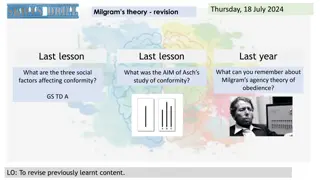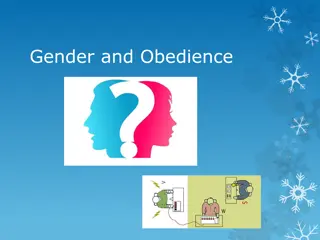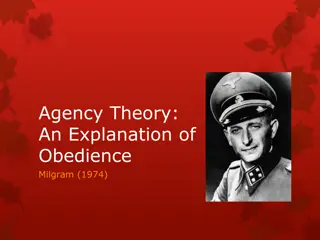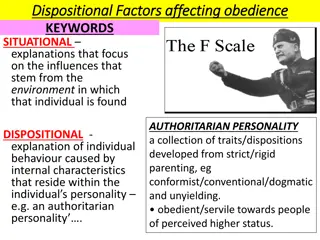Replicating Milgram's Obedience Study: Burger's Contemporary Research
Burger's 2009 study aimed to partially replicate Milgram's famous obedience experiments to explore if obedience levels have changed over time, focusing on the influence of situational factors. Using a similar setup, Burger found that individuals still exhibit high obedience rates, challenging assumptions about the impact of awareness and individual differences. The study also investigated the effect of gender and personality traits on obedience. Burger's findings highlighted the importance of situational factors in obedience behavior.
Download Presentation

Please find below an Image/Link to download the presentation.
The content on the website is provided AS IS for your information and personal use only. It may not be sold, licensed, or shared on other websites without obtaining consent from the author. Download presentation by click this link. If you encounter any issues during the download, it is possible that the publisher has removed the file from their server.
E N D
Presentation Transcript
One contemporary study from Social Psychology: Burger (2009) REPLICATING MILGRAM WOULD PEOPLE STILL OBEY TODAY?
Milgram, era and ethics Milgram s work raised many ethical questions Diana Baumrind and various others, e.g. Mixon, (1972) Burger s was the first study using almost exactly the same procedure in three decades.
Aims to conduct a partial replication of Milgram s studies to check whether findings were era-bound to enable useful comparisons with the original to protect the participants well being through careful modification
Burgers generator was just like Milgrams last shock was 450V same as Milgram Burger terminated trials if Pps went to continue past 150V Burger had carefully analysed all Milgrams s data; 150V was the point-of-no- return for 79% who then went on up to 450V Burger decided to cut them off at 150 so they couldn t suffer too much distress and then estimated that 79% of these Pps would have gone all the way .
Furthermore Burger also aimed to explore whether obedience was affected by gender 2 personality traits empathic concern desire for personal control.
His hypotheses: Era Would obedience be lower as people are more aware nowadays of the dangers of blindly following authority? Blass (2004) reviewed many similar studies; no evidence for a change over time Burger predicted strong situational factors will bring out high levels of obedience even in 2009
Fundamental Attribution Error People who suggest it will be lower, he says, are focusing too much on individual differences and overlooking the role of the power of the situation Fundamental Attribution Error means wrongly assuming that a person s behaviour is caused by their personality not the situation
Gender Burger thought that male and females would return very similar findings as in the original Milgram study. Blass s (2000) review paper had found no evidence of a gender difference in 8/9 replications of Milgram s studies.
Situational factors Modelled refusal (disobedient stooge) Burger thought that if Pps observed another person who refused to shock the learner, this might provide them with useful information about what participants are supposed to do in this setting He predicted that Pps might use this behaviour to guide them and therefore show lower levels of obedience, as Milgram had seen in his 1965 variation. this norm information would guide them in the ambiguous situation, where the experimenter s requests conflicted with their own desire to keep the learner safe.
Personality: There is not much work looking at the role of personality Blass s review (1991) suggests that individual differences in personality may account for some of the variance in obedience rates Burger predicted that Pps with higher scores for empathic concern should administer lower shocks Pps with higher desire for personal control would administer lower shocks.
Procedure every reasonable measure was taken to ensure that the participants were treated in a humane and ethical manner procedure was approved by the Santa Clara University institutional review board
5 ethical safeguards to protect Pps two-step screening process to exclude anyone who might have a negative reaction to the experience at least three reminders (twice in writing) that Pps could withdraw from the study at any time and still receive their $50 for participation a 15-volt shock used (rather than the 45-volt) to convince Pps that the shock generator was real an almost immediate debrief where Pps were told that they had not given any real shocks to the learner and where Pps meet the actor to reassure them that he was fine a clinical psychologist is present at all times and told to end the study immediately if any signs of excessive stress are seen
The participants Sampling technique: volunteer sample from ads in a local newspaper and on online listing service, libraries, farmer s markets, coffee shops, and community centres. Sample size: 70 adults Gender: 29 men and 41 women Age: 20-81 yrs, mean age of 42.9 Level of education: 60% had university degrees (bachelors and/or masters) Ethnicity: 55% were white 4% were black Afro-American.
Screening two stages to ensure their psychological suitability phoned bya research assistant, to check whether they had been to college and done any psychology (screened out people familiar with Milgram s study) If they had taken more 2+ psychology classes they were excluded 6 people actually deselected themselves at this stages, 5 knew about the Milgram study, 1 didn t want to carry on
Asked 6 questions Have you ever been diagnosed with a psychiatric disorder? Are you currently receiving psychotherapy? Are you currently taking any medications for emotional difficulties such as anxiety or depression? Do you have any medical conditions that might be affected by stress? Have you ever had any problems with alcohol or drug use? Have you ever experienced serious trauma, such as child abuse, domestic violence, or combat?
The final sample Approx 30% who responded to the ads were excluded during the initial screening, (the phone call). Pps who got through this screening were then screened again at the university Beck s Depression and Anxiety questionnaires 30 minute interview with clinical psychologist, told to err on the side of caution when deciding whether to allow the Pps to continue with the procedure. Final decisions about who could participate were based on questionnaire data and the semi-structured interviews 47/123 were deselected, (38%).
Personality tests Empathic Concern: the tendency to experience feelings of sympathy and compassion for unfortunate others . Measured using a subscale from The Interpersonal Reactivity Index a 28-item self-report inventory Desire for Personal Control: extent to which test takers are motivated to see themselves in control of the events in their lives. The Desirability of Control Scale 20-item self-report inventory designed to measure the
Design 70 Pps randomly assigned to one of two conditions, (independent measures) attempt made to keep the gender ratios in the conditions approximately equal.
Procedure script based on Milgram s research from Experiment 5 experimenter, (a white Caucasian male in his 30s) explained that the research was concerned with the effects of punishment on learning informed participants that one would play the role of teacher and the other the role of learner roles decided through a random drawing of straws (rigged: participant always plays the teacher , confederate always plays the learner) consent forms signed pps told they can withdraw any time and keep the $50 payment might be videotaped during the study
experiment was taped by two hidden cameras experimenter took learner (confederate) and the teacher (participant) to next room table and chair, intercom box and box with a set of four switches learner/confederate sit in the chair, experimenters secures his arms to armrests with nylon straps; explains this is necessary to prevent excessive movement during the experiment. electrode attached to the confederate s left wrist plus electrode paste, to provide a good contact to prevent blisters or burns.
experimenter points out that the electrode is connected to the shock generator in the next room participant watches the whole process experimenter shows learner a list of sample problems and gives instructions just as Milgram did;
Very similar to Milgram Learner must try to remember each of 25 word pairs read by the teacher (e.g. strong arm) teacher reads first word in each pair followed by four other words Learner s task is to indicate by pressing one of four buttons which option word was paired with the word on the original list incorrect answers result in electric shocks; test continues until all 25 word pairs are learned.
confederate says, I think I should say this. When I was in Kaiser Hospital a few years ago, they detected a slight heart condition. Nothing serious. But as long as I m getting these shocks how strong are they? How dangerous are they? experimenter : While the shocks may be painful, they re not dangerous. experimenter and participant return to the experiment room, experimenter closes the door to the learner s room and the lab room behind him.
The shock generator participant is seated in front of the shock generator approx 3 feet long, 15 inches high, and 16 inches deep label in the upper left-hand corner Shock Generator, Type ZLB, Dyson Instrument Company, Waltham, Mass. Output 15 volts 450 Volts. 30 switches labelled with voltages 15 to 450 (15-volt increments)
experimenter gives Pp instructions on how to press the switches, switches remain in middle position after being pressed, so you know where you have got to participant receives sample shock if they agree (two declined) of 15V experimenter hands pp list of 25 word pairs and reminds them what to do; exact same words pairs used as Milgram studies. experimenter explains that Pps must read the first word from each of the 25 pairs and then four options; If he gives the wrong answer, you say, wrong and then tell him the number of volts you are going to administer. Administer the punishment, read him the correct word pair once, and then go on to the next line.
reviews procedure one final time experimenter says, Each time he gives a wrong answer, you move up one switch on the shock generator. It s important that you follow the procedure exactly. experimenter pretends to turn on the intercom system (which was always on). explains it is a one-way system; confederate could hear what the participant said but could not respond through the intercom experimenter sits at table approx 4ft behind Pp
experimenter assists Pps who have difficulty with the procedure (often the case with the first few items) otherwise limited comments except those below confederate responds to each test item by pressing one of the buttons on the switch box that lit up either 1, 2, 3, or 4 on the answer box in participants room confederate gave correct and incorrect responses according to the same schedule as Milgram s research computer inside the shock generator attached to a speaker on the confederate s side of the wall, programmed so that pre- recorded sounds emanate from the speaker when certain switches were pressed; Pps thought they were listening to the confederate s voice through the wall
After participants pressed the 75-volt switch, they heard a small grunt (Milgram described as ugh ) Participants heard grunts after each successive shock, each grunt a little louder than the previous one when Pps press the 150-volt switch, he or she heard the confederate yell through the wall, Ugh. That s all. Get me out of here. I told you I had heart trouble. My heart s starting to bother me now. Get me out of here, please. My heart s starting to bother me. I refuse to go on. Let me out.
experimenter was instructed to end the experiment when the participant either .. (a) refused to continue after hearing all the experimenter s prods or (b) read the next item on the test after hearing the confederate s protests following the participant s press of the 150-volt switch
If at any point during the learning task the participant expressed either verbally or nonverbally a reluctance to continue the study, the experimenter gave one of four prods, in this order: Please continue or Please go on The experiment requires that you continue It is absolutely essential that you continue You have no other choice, you must continue.
prods were given in sequence each time the participant hesitated to continue, beginning with the first prod If the participant continued to express reluctance after the fourth prod, the experimenter ended the study No participant was allowed to press any more switches after pressing the 150-volt switch
experimenter gave predetermined answers to specific questions by the participant. If Pps asked whether the learner would suffer physical damage from the shocks, the experimenter said, While the shocks may be painful, there is no permanent tissue damage. If the participant said that the learner did not want to continue, the experimenter said, Whether the learner likes it or not, you must go on until he has learned all the word pairs correctly. If the participant asked who was responsible for any harm to the learner, the experimenter said, I am responsible. If the participant asked about the money he or she was given for participation or wanted to give back the money, the experimenter said, The money is yours to keep regardless.
any of these specific questions also was considered an indication that the participant did not want to continue; to keep from sounding repetitive, the experimenter sometimes varied the wording of these statements slightly, also varying the exact phrasing in order to suit exactly what the Pps asked as soon as the experimenter announced that the study was over, he told the participant that the shock generator was not real and that the confederate was not receiving electric shocks confederate entered the lab room at that point to assure the participant that he was fine. once the participant understood the situation, s/he was escorted to a nearby room, where they were thoroughly debriefed
The modelled refusal condition (disobedient stooges) Participants in this condition went through the same procedures as participants in the baseline condition, with a few exceptions two confederates were used; one was the same man who played the learner in the base condition the other confederate, also posing as a participant, was of the same gender as the real participant for the women, this second confederate was a white caucasian woman in her late 20s. for the men, the confederate was a white caucasian man in his mid-30s
a rigged drawing of straws was again used and the real pps was always the teacher 2 and the new confederate was assigned the role of Teacher 1. Both teachers watched the learner being strapped into the chair both were given a sample electric shock (the confederate went first). the experimenter instructed both teachers to sit next to one another in front of the shock generator
Teacher 1 reads the list of word pairs and pressing the switches for every mistake The confederate showed no signs of hesitation until hearing the learner s ugh! after pressing the 75-volt switch At that point, the confederate paused for a few seconds before continuing After pressing the 90-volt switch and hearing another ugh!, the confederate glanced at the experimenter and said, I don t know about this. The experimenter responded with his initial prod, Please continue. The confederate paused a few seconds, then said, I don t think I can do this, and pushed his or her chair a few inches back from the table
The experimenter then asked the real participant to continue the test, picking up where the other teacher had left off. The confederate sat silently throughout the rest of the study and avoided making eye contact with the participant
Findings Obedience rates were only slightly lower than those Milgram found 45 years earlier 70% pressed the 150V button compared with 82.5% in Milgram s experiment 5. Contrary to expectation, 63% of participants who saw a confederate refuse the experimenter s instructions at 90V obeyed orders and pressed the 150V switch, almost the same number as saw no rebellious stooge (70%), however this was only one act of rebellion, and it occurred when the learner did not seem too bothered by the procedure, whereas in Milgram s variation the Pps saw two acts of rebellion which occurred at 150V and 210V , when the learner had started complaining and withdrawing his consent.
Effects of gender: minimal Men and women did not differ in their rates of obedience although women were slightly more likely than men to press the 150V switch in the base condition (men 66.7%, women 72.7%, not sig) and the modelled refusal condition (54.5% men, 68.4% women) the differences were not significant in either condition also it was found that first prod scores, (i.e. where Pps first started to protest) were also very similar.
Personality There was no significant difference in the empathic concern scores between the defiant (baseline condition: 19.25) and obedient Pps (baseline condition: 19.20) however the defiant Pps did have significantly higher desire for personal control scores (106.92) than obedient Pps (98.24) although this was not the case in the modelled refusal trials.
Personal control and first prod scores It was also found that there was a significant negative correlation of -0.33 between first prod voltages and desire for personal control scores whereby the higher the desire for personal control the lower the voltage of the switch where the pp made their first protest requiring a prod from the experimenter.
Conclusions Milgram s original findings are not era bound in that participants in the baseline condition were equally as obedient as they were 40 years ago this said, one stark difference was that Participants were less likely to follow the lead and become defiant having observed a disobedient stooge and this was contrary to expectation. Milgram s findings are not androcentric as women s obedience rates were very similar to mens.
Empathic concern Lack of empathy for the learner does not seem to be a valid explanation for the high levels of obedience seen defiant and obedient participants had very similar empathic concern scores although it was noted that those with higher empathic concern scores did protest to the experimenter earlier in the proceedings but this did not stop them from following orders.
Desire for personal control Desire for personal control does seem to dictates defiance/obedience possible that the reason there was not a correlation in the modelled refusal condition is that those with high desire for personal control carried on when they had witnessed the rebellion as they wanted to feel that they had made their own personal judgement about when to drop out as opposed to simply conforming to the confederate.
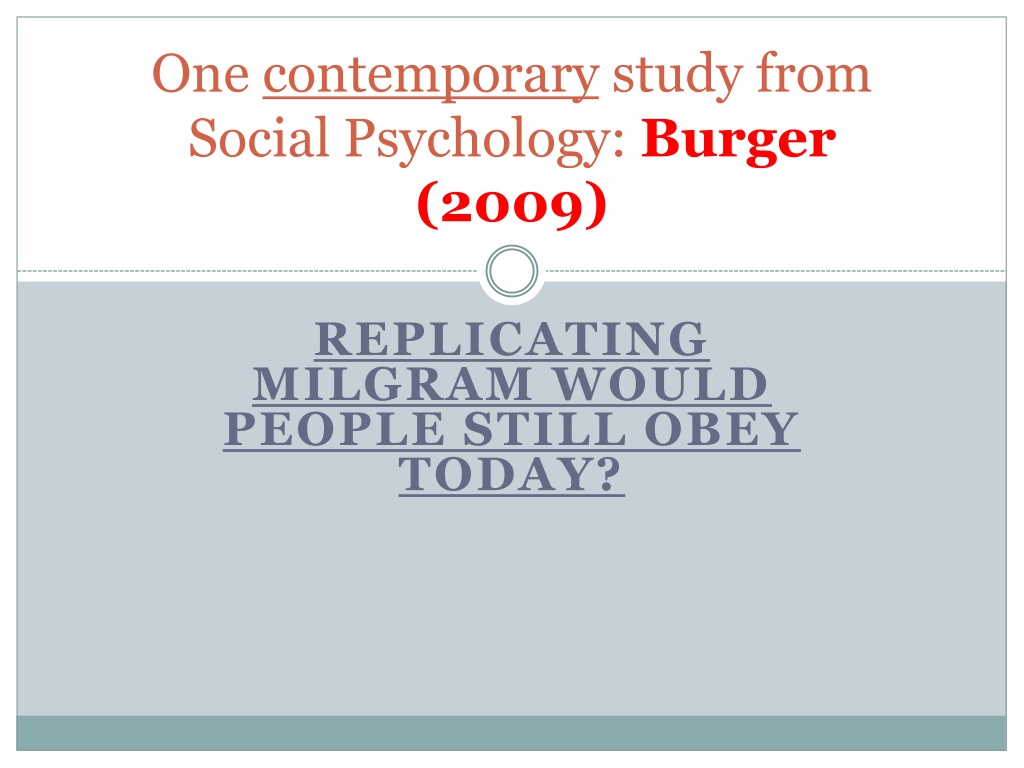
 undefined
undefined





















![GET [✔PDF✔] DOWNLOAD✔ The Ultimate Burger: Plus DIY Condiments, Sides, and](/thumb/68033/get-pdf-download-the-ultimate-burger-plus-diy-condiments-sides-and.jpg)

